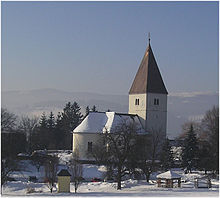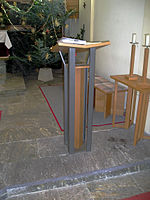Freiland parish church near Deutschlandsberg
The Roman Catholic parish church Freiland bei Deutschlandsberg is located in Freiland bei Deutschlandsberg in the municipality of Deutschlandsberg in western Styria . The church, originally consecrated to St. Leonhard of Limoges , was consecrated to St. James the Elder in the 16th century and until the end of August 2018 belonged to the then dissolved deanery of Deutschlandsberg in the diocese of Graz-Seckau ; since this deanery was closed, it has been located in the pastoral care area of Southwest Styria. The church is a listed building .
Parish history
The first church consecration, already as a parish, is mentioned in 1188.
As early as 1203 the parish was incorporated into Admont Abbey. Until 1244 the parish belonged to the Archdiocese of Salzburg. Between 1244 and 1786 the parish belonged to the diocese of Lavant . In 1786 the parish was incorporated into the Graz-Seckau diocese . From 1805 to 2018 the parish belonged to the dean's office in Deutschlandsberg . While the parish belonged to the Bailiwick of the Benedictine Abbey of Admont, the provost office of St. Martin near Graz acted as administrator. In 1893, an independent parish was built around the St. Oswald in Freiland church, which had been a branch church (localie) from St. Jakob .
The parish was handed over to the diocese of Graz-Seckau in 1981 by the Admont Benedictine Abbey. Under canon law, the leading priests of the parish (as well as those in the neighboring parish of St. Oswald until 1981) were partially parish vicars , i.e. deputies of a pastor , because the parish was incorporated into the Admont Abbey and thus the Abbey itself was considered a “pastor”. Legally, these priests had all the rights and duties of a real pastor. The basis for this was last Canon 471 of the Codex Iuris Canonici- CIC from 1917. The formal difference did not affect the reputation and functions of the priests in practice, but must be taken into account when a priest from free land is referred to as a vicar in documents. It is not a matter of deputy, but of the actual holder of the pastor's function. Since the 1980s, the parish forms, together with the parish church Germany Berg, the parish of St. Oswald ob field and Osterwitz the Pfarrverband Germany Berg .
History of the church
In 1532 the church was largely destroyed in the course of the Turkish invasions. Reconstruction takes place in the next two years. On October 24, 1534, Philipp Renner consecrated the new cemetery and parish church as coadjutor of Lavant Bishop Leonhard Peurl , whose patrons were St. James and St. Leonhard . Three altars were also consecrated:
- The high altar was consecrated to the two patrons of the church, whereby the relics of the altar in the consecration protocol, in addition to those of the church patron, include those of the Holy Cross , the cradle and the table of the Lord ( Latin de cunabulis domini, de tabula domini ) and John (evangelist) and unknown saints are given.
- The left altar (seen from the entrance) was dedicated to the Immaculate Virgin Mary . As his relics are clothes (vestimentum) of St. Mary and relics of St. Alexander , St. Eventius (martyrs in the retinue of St. Alexander), St. Theodore (a former patron of Venice ), St. Ursula with their companions ( Latin et sodalibus ), St. Kunigunde and the (unknown) virgin Vermeta.
- The right altar was dedicated to all the apostles. His relics are those of the apostles Peter and Matthias , as well as St. Blaise , St. Pancras and other saints.
A bell consecration for the parish church (called S.Jacobi in Saboth ) is documented on October 17, 1637 in Groß St. Florian.
In 1657 the Marian altar was purchased.
After the church was destroyed by a devastating fire in 1733, the church was rebuilt the following year under builder Josef Carlone . The church was consecrated again on October 28, 1735.
After 1757 an organ was purchased which is still in use today and which is declared a cultural asset worthy of protection . The organ was probably built as a positive by Kaspar Mitterreither in the Baroque period and later expanded with a pedal . The organ was previously installed in the parish church of Bad Gams , but it is unknown when it came to Freiland. A restoration was carried out in 1960 by master organ builder Krenn from Graz, another in 2014 by the Vonbank organ builder in Murau. The restored organ was inaugurated on January 18, 2015 by Bishop Egon Kapellari .
After a lightning strike in 1962, the church was renovated again.
Furnishing
The high altar shows a representation of St. James , enthroned above the Trinity . The Gospel side of the altar is the statue of St. Florian . On the right side of the altar is a statue of St. Rochus .
In the side altar on the right side of the church there is a statue of St. Leonhard. The side altar on the Gospel side shows a portrait of the Immaculate Conception of Mary from 1657.
The baptismal font in the tower of the church is the oldest preserved in Styria and has a baroque attachment.
The ambo and the people's altar shaped as a round wooden table were designed by the artist Alois Krammer. Above the entrance to the sacristy there is a coat of arms of the Admont Abbey, which shows the ecclesiastical origins of the building.
literature
- Maximilian Riederer, Gunther Riedlsperger, Johann Tomaschek: Freiländer Ortschronik. Self-published by the community of Freiland near Deutschlandsberg, 1988. No ISBN.
- District topography : Helmut-Theobald Müller (ed.), Gernot Peter Obersteiner (overall scientific management): History and topography of the Deutschlandsberg district. Styrian Provincial Archives and District Authority Deutschlandsberg. Graz-Deutschlandsberg 2005. In the series: Great historical regional studies of Styria. Founded by Fritz Posch †. Volume 3. ISBN 3-901938-15-X . Second part of volume, district lexicon. Pages 96-100.
Web links
Individual evidence
- ↑ Gerhard Fischer: The Catholic Church in Styria is breaking new ground. Merger of the dean's offices in Deutschlandsberg and Leibnitz to form the South-West Styria region. Weekly newspaper Weststeirische Rundschau from August 31, 2018. Volume 91, No. 35, p. 2.
- ↑ Heribert Heinemann: § 34. The pastor . In: Joseph Listl, Hubert Müller, Heribert Schmitz: Outline of post-conciliar church law. Verlag Friedrich Pustet, Regensburg 1980. ISBN 3-7917-0609-8 . Page 320: Parish vicar with necessary parish rights, permanent deputy.
- ^ Oskar Veselsky: The consecration reports from the ordination and consecration protocols of the bishops of Lavant in the 16th century. In: Sources for the historical regional studies of Styria, published by the Historical Commission for Styria - HLK, XI. Tape. Graz 1997. Self-published by HLK. No ISBN. Pages 18, 24, 80-81.
- ^ Oskar Veselsky: Lavanter ordination and consecration reports from 1586 to 1679. In: Sources for the historical regional studies of Styria, published by the Historical Commission for Styria - HLK, 22nd volume. Graz 2008. Self-published by the HLK. ISBN 978-3-901251-21-4 . Page 302.
- ↑ Cultural property protection map 1: 50,000. Sheet 198 Deutschlandsberg. According to the Hague Convention of May 14, 1954, Federal Law Gazette No. 58/1964, edited by the Documentation Center and Convention Office of the Federal Monuments Office , Vienna 1977.
- ↑ Weekly newspaper Weststeirische Rundschau from January 23, 2015. Volume 88, 2015 No. 4. Page 1.
- ^ Kurt Woisetschläger, Peter Krenn: Dehio Handbook - Die Kunstdenkmäler Österreichs: Styria (excluding Graz). Topographical inventory of monuments, ed. from the Federal Monuments Office, Department for Monument Research. Publisher Anton Schroll. Vienna 1982. ISBN 3-7031-0532-1 . Page 114.
Coordinates: 46 ° 50 ′ 50.5 ″ N , 15 ° 8 ′ 28.5 ″ E



